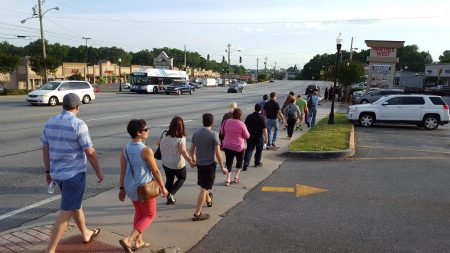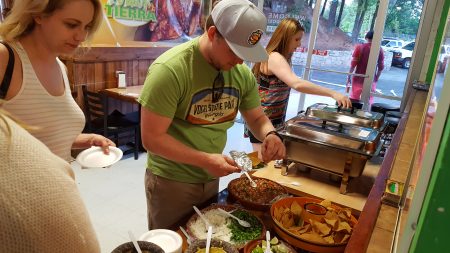More than a hundred MARTA-riding tourists got a taste of Buford Highway’s famed multicultural restaurants—seasoned with expert takes on the corridor’s safety and gentrification challenges—on an April 27 “bus crawl” staged by We Love BuHi and the MARTA Army.

While noshing on sample plates, attendees heard from such officials as MARTA planner Amanda Rhein, who set up an easel at the Plaza Fiesta mall and explained the transit agency’s proposed transit-oriented redevelopment around the Brookhaven/Oglethorpe Station. The bus crawl ended at Brookhaven’s Royal Lounge nightclub with keynote speaker Ryan Gravel, the urban planning guru who dreamed up Atlanta’s BeltLine park/transit ring.

“There’s certainly the challenge of change and displacing the thing that makes [Buford Highway] special,” Gravel said in an interview at the lounge about the corridor’s highly diverse immigrant culture. “Nowhere else has that sense of identity, that sense of place…There’s nothing else like it” in metro Atlanta or most other suburban corridors nationwide, he said. “What happens to it is really important.”

Without a new kind of culture-focused planning, Gravel told the crowd, Buford’s main asset will be displaced for another generic strip-mall suburb. He suggested turning two lanes of the roadway into bus rapid transit lanes. And instead of pumping money into standard redevelopments, he called for investing in affordable housing or “a venture capital fund for immigrant businesses.”

Bringing busloads of mostly white, non-Hispanic cultural tourists to Buford Highway was a tricky part of the bus crawl’s own displacement discussions, and sparked some local curiosity and tensions. As one group walked through the Plaza Fiesta parking lot, a passerby cracked, “Did y’all’s bus break down? That’s a lot of white people.”

MARTA Army founder Simon Berrebi said bus crawl organizers tried to not present Buford as exotic, but instead to highlight the good and the challenging. “That’s how people who live and work here live it every day,” he reminded the nightclub crowd.
“It’s not just, ‘Let’s go eat.’ It’s, ‘Let’s go eat and learn,’” said We Love BuHi founder Marian Liou about the bus crawl’s intent.
Many attendees did just that, enjoying exploring Buford and trying out MARTA’s 39 bus. Katie Lambert of Atlanta and Linda Niederhausen of Marietta teamed up to join one of several groups led from stop to stop by volunteer guides.

“This is one of the few parts of town [where] I haven’t gone to every restaurant,” said Lambert, while Niederhausen was impressed with MARTA’s service. “It was clean. That’s one of the myths—that the bus is dirty,” she said.
Chamblee residents Katja and Joerg Lauterbach said they’ve been on We Love BuHi’s previous Buford bike tours.
“We just love Buford Highway…We are adventurers, but [we attend] to be more adventurous,” Katja said, adding that as immigrants themselves—from Berlin, Germany—they appreciate the corridor and its people. “I really support the mission [Liou’s] taking on to celebrate Buford…We know how it is to be having certain language barriers.”

At Yen Jing, a Chinese restaurant in Doraville, a dumpling-munching crowd heard about the work of the Center for Pan Asian Community Services from its vice president, Victoria Huynh. Sally Flocks of the Atlanta pedestrian advocacy group PEDS explained Buford Highway’s traffic dangers outside the Bangladeshi market and café Bismillah, where there’s a dirt path instead of a sidewalk.
The star of the tour was Gravel, who grew up in Chamblee and whose 1999 grad student project of turning old railroad beds into the BeltLine is transforming Atlanta—currently as a multiuse path, but with a strong push for his original light-rail public transit vision. (Gravel said he’s “super-excited” about a transit-funding tax that goes before Atlanta voters this fall.)
Gravel signed a copy of his new book, “Where We Want to Live,” for Rebekah Morris, a teacher at Brookhaven’s Cross Keys High, while she told him about her students’ project to design their own Buford Highway visions. That student project is partly a response to a lack of Buford community input in local plans, partly due to language or cultural barriers.

Grassroots input is a big theme of Gravel’s book, he said in an interview. For the BeltLine plan, he said, Atlanta’s Neighborhood Planning Unit system was crucial for getting quick and easy community input from everywhere in the city. He said he is not an expert in Buford-area local governments, but that they appear not to have anything like NPUs. He said he has heard that Buford’s community has more of an “us versus them” relationship to local City Halls.

With metro Atlanta’s population booming and local governments doing cleanup projects like the Peachtree Creek Greenway, change is coming to Buford Highway, Gravel said. With a “thoughtful” approach, it can change in ways that build wealth for the existing community, he said. And with new priorities driving the planning, it could suddenly “be very easy to take [some of] those lanes away from cars and give them to people.”
“Buford Highway has to be a corridor not just for moving people in cars along,” but also for community development, health and the arts, Gravel said. “All of those things are part of what its job is.”

Comments are closed.